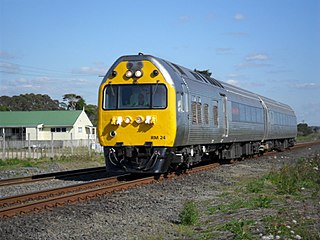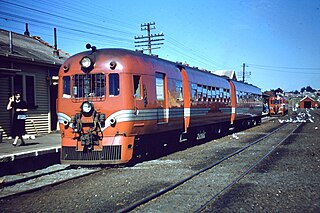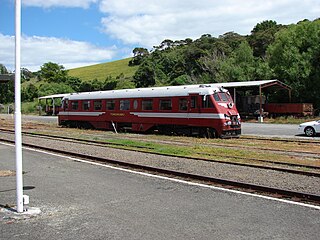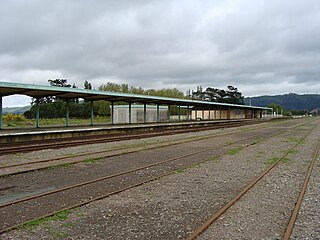
The Rimutaka Incline was a 3-mile-long (4.8 km), 3 ft 6 in gauge railway line on an average grade of 1-in-15 using the Fell system between Summit and Cross Creek stations on the Wairarapa side of the original Wairarapa Line in the Wairarapa district of New Zealand. The term "Rimutaka Incline" is sometimes used incorrectly to refer to other parts or all of the closed and deviated section of the Wairarapa Line between Upper Hutt and Speedy's Crossing, near Featherston. The incline formation is now part of the Remutaka Rail Trail.

The NZR RM class Silver Fern was a class of rail motor in New Zealand. The three air-conditioned and sound-proofed 723-kW 96-seater diesel-electric twin-set railcars were built by Kawasaki under contract with Nissho Iwai of Japan. New Zealand Railways (NZR) classified the railcars as RM (Rail Motor), the same as other railcars, using the Silver Ferns (a national symbol of New Zealand) because of their exterior was made of corrugated stainless steel, like the premier night sleeper train that also ran on the Wellington-Auckland (North Island Main Trunk) route, the Silver Star. The Silver Ferns replaced the three successful Blue Streak railcars on the service.

The Plains Vintage Railway & Historical Museum is a heritage railway and recreated historic village in the Tinwald Domain, Tinwald, New Zealand. The railway runs on approximately three kilometres of rural railway line that was once part of the Mount Somers Branch. The village and railway are open regularly to the public. The railway utilises preserved and restored locomotives and rolling stock once used on New Zealand's national railway network, while the village shows visitors how life was lived in New Zealand's pioneering past.
Locomotives of New Zealand is a complete list of all locomotive classes that operate or have operated in New Zealand's railway network. It does not include locomotives used on bush tramways.

The NZR RM class 88-seaters were a class of railcar used in New Zealand. New Zealand Government Railways (NZR) classified them as RM (Rail Motor), the notation used for all railcars, numbering the 35 sets from RM100 to RM134. They were the most numerous railcars in NZR service. Their purchase and introduction saw the demise of steam-hauled provincial passenger trains and mixed trains, and was part of a deliberate effort to modernise NZR passenger services at a time of increasing competition from private motor vehicles. Being diesel powered and lighter the railcars were less expensive to operate and able to maintain quicker timetables, although became plagued with mechanical and electrical problems, with a number of the class eventually being turned into depowered locomotive-hauled carriages and reclassified as the AC class "Grassgrubs".

The Wairarapa Line is a secondary railway line in the south-east of the North Island of New Zealand. The line runs for 172 kilometres (107 mi), connects the capital city Wellington with the Palmerston North - Gisborne Line at Woodville, via Lower Hutt, Upper Hutt and Masterton.

The NZR RM class Wairarapa railcar was a class of railcars on New Zealand's national rail network. They entered service in 1936 and were classified RM like all other classes of railcars in New Zealand; they came to be known as the "Wairarapa" class as they were designed to operate over the famous Rimutaka Incline to the Wairarapa region on the Wairarapa Line. They also acquired the nickname of "tin hares" in New Zealand railfan jargon. The first two to be introduced re-used the numbers RM 4 and RM 5 that had previously been used by the withdrawn experimental Model T Ford railcars. The class consisted of six passenger railcars and one passenger-freight railcar. It is often described incorrectly as a class of six railcars.

The NZR RM class Standard railcars were a class of railcar operated by the New Zealand Railways Department (NZR) in the North Island of New Zealand. Officially classified as RM like all other railcar classes in New Zealand, they acquired the designation of "Standard" to differentiate them from other railcar classes. They were introduced in 1938 and withdrawn in 1972.

The RM class was the classification used by the New Zealand Railways Department (NZR) and its successors gave to most railcars and railbuses that have operated on New Zealand's national rail network. "RM" stands for Rail Motor which was the common name at the turn of the 20th century for what became known in New Zealand as railcars. As many types of railcars are operated, class names have been given to each railcar type to differentiate them from others.
The Taranaki Flyer was the name given to a passenger train that was operated by the New Zealand Railways Department between Whanganui and New Plymouth from 1926 to 1965.
The Wairarapa Mail was a passenger train operated by the New Zealand Railways Department (NZR) between Wellington and Woodville, continuing on to Palmerston North as a mixed train. It ran from 1909 until 1948 and its route included the famous and arduous Rimutaka Incline.

Masterton railway station is a single-platform, urban railway station serving the town of Masterton in New Zealand's Wairarapa district. Located at the end of Perry Street, it is one of three stations in Masterton, the others being Renall Street and Solway. Masterton station is the terminus for Wairarapa Connection passenger services on Metlink's Wairarapa Line from and to Wellington. The average journey time to Wellington is one hour and forty-three minutes.
The Wairarapa Railway Restoration Society is a railway heritage and preservation community group in the town of Carterton, in the Carterton District of Wairarapa on New Zealand's lower North Island. The society has leased the Carterton railway station building through the Carterton District Council, though it is owned by the New Zealand Railways Corporation.

Woodville railway station is the northern terminus of the Wairarapa Line and is located at the junction with the Palmerston North–Gisborne Line in the small Tararua town of Woodville, 27 km (17 mi) east of Palmerston North in New Zealand's North Island.

Pahiatua railway station is on the Wairarapa Line in New Zealand's North Island. It was opened in May 1897, shortly before the line was opened to Woodville in December of that year. The station is located in Mangamutu, 1.7 kilometres (1.1 mi) west of Pahiatua, in contrast to the original plans for the railway line to run through the town.

Mangamahoe railway station served the small rural community of Mangamahoe in the Wairarapa region of New Zealand’s North Island. It was located on the Wairarapa Line between the stations of Mauriceville and Eketahuna with vehicular access from Station Road. It is the northernmost station site on the Wairarapa Line within the jurisdiction of the Greater Wellington Regional Council before the line passes into territory governed by Horizons Regional Council.

Opaki railway station served the small rural village of Opaki, 6 km (3.7 mi) north of Masterton, in the Wairarapa region of New Zealand’s North Island. It was located on the Wairarapa Line between the stations of Masterton and Kopuaranga with vehicular access from Wingate Road.

Eketahuna railway station was a station on the Wairarapa Line, a railway line that runs through the Wairarapa region of New Zealand's North Island. Located between the stations of Mangamahoe and Newman, it served the small southern Tararua town of Eketahuna and was one of the few attended stations on the northern section of the line.

The Mangatainoka railway station on the Wairarapa Line was located in the Tararua District of the Manawatū-Whanganui region in New Zealand’s North Island. Located between the stations of Pahiatua and Ngawapurua, it served the farming settlement of Mangatainoka and surrounding districts.

















